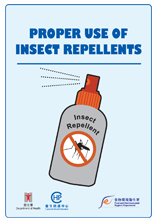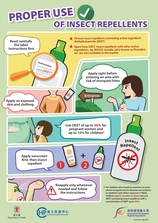Tips for using insect repellents
2024-09-26
- Choose insect repellents containing active ingredient such as diethyltoluamide (DEET)
- Read carefully the label instructions first
- Apply DEET containing insect repellents to exposed parts of the body and clothing in accordance with label instructions and precautions.
- Avoid using DEET containing insect repellents in infants under 6 months of age*. Use alternative measures to prevent vector bites and stings.
- When DEET containing insect repellents are to be used in children:
- Use lower concentration of DEET — up to 10%*
- Do not allow children to handle insect repellents or apply it by themselves. Adults should apply insect repellents to their own hands and then put it on children
- Do not apply to young children’s hands, around eyes and mouth, or on broken or irritated skin
- Do not let insect repellents get into their eyes
- Roll-on preparations are preferable to sprays
- Spray repellents in open areas and do not allow children to breathe in
- Store repellents out of the reach of children and do not allow children to swallow them
- Limit application to the skin and reinforce application to clothing
- Wash children's treated skin with water or bathe them after they have returned indoors
- Use soap and water to wash the clothes exposed to insect repellents; and
- Advise nursing mothers to wash repellents off their hands and body before breastfeeding their infants
- * For children who travel to countries or areas where mosquito-borne diseases are endemic or epidemic and where exposure is likely, children aged 2 months or above can use DEET-containing insect repellents with a concentration of DEET up to 30%.
- For recommendation of pregnant women using DEET containing insect repellent, please visit the Family Health Service website.
- Using insect repellents containing DEET should not be harmful if label instructions are followed and the product is used safely. In rare cases, using DEET products may cause skin rashes. Some persons who used products containing a high concentration of DEET or who were exposed to excessive amounts of DEET have experienced skin rashes, blisters, and skin and mucous membrane irritation.
- Apart from DEET, insect repellents with other active ingredients, e.g. IR3535, Icaridin (also known as Picaridin), etc. are also available in the market. When using any insect repellent, members of the public are advised to follow the label instructions and precautions.
Other languages
| Bahasa Indonesia Version Bahasa Indonesia |
Tagalog Version Tagalog |
Thai Version ไทย |
| Hindi Version हिन्दी |
Nepali Version नेपाली |
Urdu Version اردو |
| Vietnamese Version Tiếng Việt |
Punjabi Version ਪੰਜਾਬੀ |

